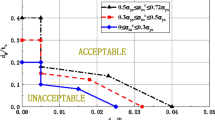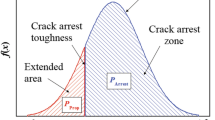Abstract
In view of the important influence of mechanical damage on the bearing capacity of buried pipelines, the residual strength of dented pipelines has become a hot issue in the pipeline industry. In this paper, X52 steel grade, commonly used in buried pipelines, is taken as the research object. The material properties are obtained by tensile test. The difference of curvature radius at the tip of the dent is accurately considered. Based on finite element method, the limit depth and the failure pressure of the dented pipelines are studied. Results have shown that the ultimate displacement load increases exponentially with the increase in the radius of curvature. When dent depth is small, the dent will not reduce the failure pressure, no matter it is smooth or sharp. As the dent depth increases, the influence of the radius of curvature at the tip of the dent becomes significant. The critical radius of curvature from sharp dent to smooth dent is analyzed. And the corresponding relationship between it and dent depth is obtained. It is found that when the radius of curvature exceeds 50 mm, the dent depth does not affect the failure pressure of the pipeline. An expression about the two parameters is put forward, providing supplementary suggestions for the depth-based evaluation criterion. This paper affords a strong support for better assessment of dented pipelines.









Similar content being viewed by others
Abbreviations
- \(D\) :
-
The outside diameter of the pipe (mm)
- \(t\) :
-
The wall thickness of the pipe (mm)
- \(h_{0}\) :
-
Dent depth without spring back/displacement load of the indenter (mm)
- \(h\) :
-
Dent depth after spring back (mm)
- \(h_{\lim }\) :
-
The ultimate displacement load (mm)
- \(h_{\text{crit}}\) :
-
The critical dent depth (mm)
- \(E\) :
-
Elastic modulus (GPa)
- \(\mu\) :
-
Poisson’s ratio
- \(\sigma_{\text{s}}\) :
-
Engineering yield strength (MPa)
- \(\sigma_{\text{u}}\) :
-
Engineering tensile strength (MPa)
- \(\sigma_{\text{u}}^{\prime }\) :
-
True tensile strength (MPa)
- \(r\) :
-
Radius of curvature of the indenter/dent (mm)
- \(r_{\text{crit}}\) :
-
The critical radius of curvature (mm)
- \(p\) :
-
Internal pressure (MPa)
References
Y.F. Yang, X.D. Ge, H.L. Zheng et al., Influence laws of third party damage on pipeline reliability. Oil Gas Storage Transp. 36(8), 903–909 (2017)
G. Pluvinage, M. Allouti, C. Schmitt et al., Assessment of a gouge, a dent, or a dent plus a gouge, in a pipe using limit analysis or notch fracture mechanics. J. Pipeline Eng. 10, 147 (2011)
A. Cosham, P. Hopkins, The effect of dents in pipelines—guidance in the pipeline defect assessment manual. Int. J. Press. Vessels Piping 81(2), 127–139 (2004)
J.H. Baek, Y.P. Kim, C.M. Kim et al., Effects of pre-strain on the mechanical properties of API 5L X65 pipe. Mater. Sci. Eng., A 527(6), 1473–1479 (2010)
X. Ma, X. Tao, T.M. Shi et al., Analysis on influence factors of dent pipeline safety. J. Saf. Sci. Technol. 12(6), 123–127 (2016)
Z.Q. Lei, J. Chen, F.X. Wang et al., A calculation method for the strain of pipeline dents based on ILI data. Oil Gas Storage Transp. 35(12), 1275–1280 (2016)
ASME B31.4-2016. Pipeline transportation systems for liquids and slurries, USA (2016)
ASME B31.8-2018. Gas transmission distribution piping system, USA (2010)
CSA Z662-2011. Oil and gas pipeline systems, Canada (2007)
API 1169-2007. Pipeline construction inspector, USA (2007)
API 1160-2001. Managing system integrity for hazardous liquid, USA (2001)
SY/T 6996-2014. Assessment of steel oil and gas pipeline with dent[S], China (2014)
R.J. Eiber, W.A. Maxey, C.W. Bert, et al., The effects of dents on the failure characteristics of line pipe. NG-18 Report No.125, American Gas Association Catalog No. L51403 (1981)
B. Han, Z.Y. Wang, Z.Z. Wu et al., Application of strain-based theory in failure analysis of pipeline subjected to mining collapse areas. J. China Univ. Pet. 36(04), 134–138 (2012)
M.W. Cui, X.W. Cao, Z.Y. Feng et al., Calculation method of oil–gas pipeline failure pressure with localized corrosion. J. China Univ. Pet. 37, 123–128 (2013)
H. Ghaednia, S. Das, R. Wang et al., Safe burst strength of a pipeline with dent–crack defect: effect of crack depth and operating pressure. Eng. Fail. Anal. 55, 288–299 (2015)
X. Tian, H. Zhang, Failure pressure of medium and high strength pipelines with scratched dent defects. Eng. Fail. Anal. 78, 29–40 (2017)
X. Tian, H. Zhang, Failure criterion of buried pipelines with dent and scratch defects. Eng. Fail. Anal. 80, 278–289 (2017)
M. Allouti, C. Schmitt, G. Pluvinage et al., Study of the influence of dent depth on the critical pressure of pipeline. Eng. Fail. Anal. 21(1), 40–51 (2012)
O.H. Bjørnøy, O. Rengård, S. Fredheim, et al., Residual strength of dented pipelines, DNV test results, in International Offshore and Polar Engineering Conference, pp. 182–188 (2000)
M.F. Li, L. J. Zhou, Z. Ren, et al., Progress in the inspection and the assessment of dents in oil and gas pipeline, in Proceedings of CIPC 2013 China International Oil and Gas Pipeline Conference, vol. 7 (2013)
Author information
Authors and Affiliations
Corresponding author
Additional information
Publisher's Note
Springer Nature remains neutral with regard to jurisdictional claims in published maps and institutional affiliations.
Rights and permissions
About this article
Cite this article
Tian, X., Lu, M. & Chen, Y. Numerical Simulation Method for Failure Pressure of Buried Dented Pipeline. J Fail. Anal. and Preven. 20, 944–949 (2020). https://doi.org/10.1007/s11668-020-00897-8
Received:
Revised:
Published:
Issue Date:
DOI: https://doi.org/10.1007/s11668-020-00897-8




